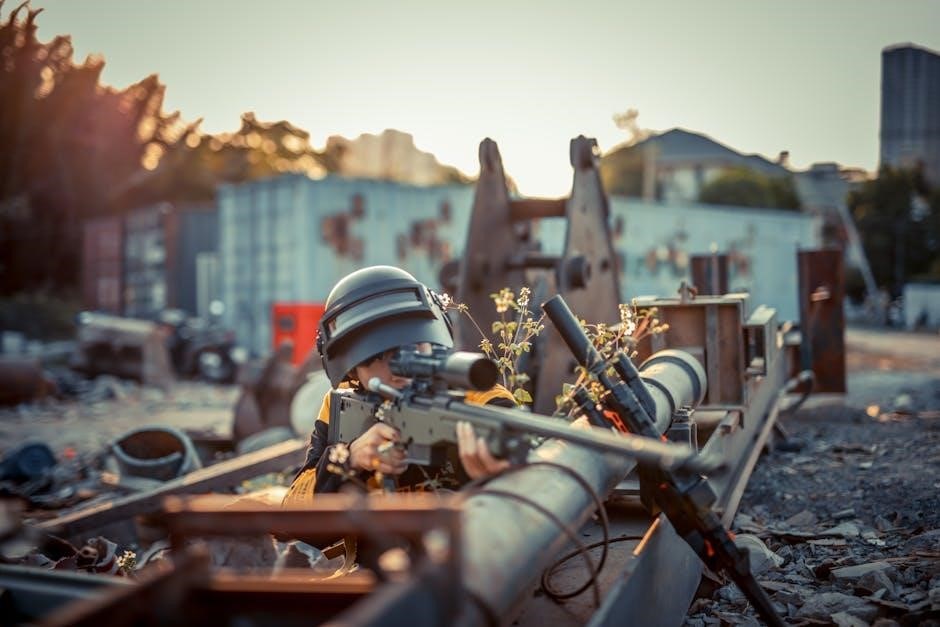
Rust Game Guide: A Comprehensive Overview
Rust, a challenging multiplayer survival game, demands strategic gameplay and resourcefulness; this guide offers essential tips for beginners and veterans alike, covering all aspects.
Rust is a brutal, multiplayer online survival game developed by Facepunch Studios, known for its unforgiving environment and complex player interactions. Players awaken on a vast island with limited resources, tasked with surviving the elements, wildlife, and, most importantly, other players.
The core gameplay revolves around gathering resources, crafting tools and weapons, building shelters, and forming alliances – or engaging in conflict. Unlike many survival games, Rust emphasizes player-driven narratives and emergent gameplay; There’s no overarching story; instead, players create their own experiences through raiding, trading, and establishing dominance.
Success in Rust requires a deep understanding of its mechanics, strategic thinking, and a willingness to adapt. This guide will provide a comprehensive overview, helping you navigate the challenges and thrive in this harsh world.
Understanding the Core Gameplay Loop
The heart of Rust lies in a continuous cycle of survival, progression, and conflict. It begins with scavenging for basic resources – wood, stone, metal fragments – to craft rudimentary tools and weapons. These tools enable more efficient gathering, leading to better gear and the ability to construct more robust shelters.
Building a base isn’t merely about protection; it’s a statement of intent and a hub for crafting and storage. However, bases attract attention, initiating the PvP aspect of the game. Players raid each other for resources, creating a dynamic and often chaotic environment.
This loop – gather, craft, build, raid, repeat – defines the Rust experience. Mastering resource management, understanding blueprint acquisition, and developing strategic combat skills are crucial for long-term survival and dominance.

Getting Started in Rust
Rust demands immediate action; quickly install the toolchain, create a character, and begin gathering essential resources to survive the harsh initial environment.
Installing Rust and Setting Up Your Environment
Rust’s initial step involves downloading and installing the Rust toolchain, a crucial process for development and gameplay. Resources like Rustlings offer guided setup, ensuring a smooth experience for newcomers. Alternatively, directly downloading the toolchain from the official Rust website is viable.
Following installation, configuring your development environment is key. While any editor suffices, ensure it supports basic Rust syntax highlighting. Tutorials emphasize having a preferred editor already in place. The process involves adding Rust’s binaries to your system’s PATH, enabling command-line access.
Verification is simple: open a terminal and run rustc --version. Successful output confirms a correctly installed environment, ready for coding and exploring Rust’s capabilities. This foundational step unlocks access to the game’s core mechanics and allows for further customization.
Creating Your First Character
Upon launching Rust, character creation is streamlined, focusing on minimal customization initially. Players spawn naked and unarmed, immediately thrust into the harsh survival environment. There are no extensive appearance options at the start; the priority is immediate survival, not aesthetics.

The initial spawn location is randomized, demanding quick adaptation to the surrounding terrain. Understanding the core gameplay loop – gathering, crafting, building – begins instantly. Players must quickly locate resources like wood and stone to craft basic tools.
Character progression in Rust is largely skill-based, earned through consistent play and resourcefulness. Early character creation is less about defining a persona and more about preparing for the challenges ahead. Expect a steep learning curve and a constant need to adapt to survive.

Initial Survival: Gathering Resources
Rust’s initial hours are defined by frantic resource gathering. Prioritize wood and stone – fundamental for crafting basic tools like stone axes and pickaxes. These tools unlock access to more efficient resource collection, accelerating your progress. Focus on gathering berries and mushrooms for early sustenance, mitigating hunger.
Scavenging abandoned monuments and road signs provides essential components like cloth and metal fragments. Be cautious; these areas often attract other players. Learning to quickly identify resource nodes and efficiently harvest them is crucial.
Early resource management is key; avoid wasting materials. Understanding the crafting recipes and prioritizing essential items will significantly improve your chances of surviving the first night. Constant vigilance and efficient gathering are paramount.

Essential Crafting and Building
Crafting unlocks vital tools and weapons, while building provides shelter and security; mastering both is fundamental to Rust survival and long-term progression.
Basic Tools and Weapons
Early-game survival in Rust hinges on acquiring fundamental tools. The stone hatchet is your initial workhorse for gathering wood, crucial for fires and building. Progressing to a metal hatchet significantly increases efficiency. Simultaneously, craft a stone pickaxe to mine essential resources like stone and metal ore.
For defense, the stone knife offers basic melee capability, but quickly transition to a wooden spear for increased reach and damage. Basic weapons like the revolver require resources and blueprints, offering ranged combat options. Remember to prioritize crafting low-grade fuel for tools like the chainsaw when available. Understanding these initial crafting steps is paramount for establishing a foothold in the harsh world of Rust.
Building Your First Shelter

Securing a base is vital in Rust. Begin with a small, easily constructed shelter – a 1×1 or 2×2 foundation made of wood. Prioritize walls and a door to protect against the elements and opportunistic players. Focus on a secure door and consider adding a simple wooden door code lock for basic security.
Quickly upgrade to stone foundations and walls for increased durability against raiding. Don’t neglect a roof to prevent unwanted access. Early shelters don’t need to be elaborate; functionality and protection are key. Remember to strategically position your base near resources, but also consider concealment to avoid attracting attention. A well-placed, modest shelter is a lifesaver.
Advanced Building Techniques and Base Defense
Fortifying your base requires more than just stone walls. Implement honeycomb designs, layering walls to absorb damage and slow down raiders. Utilize airlocks – multiple doors creating a buffer zone – to funnel attackers. Reinforce key areas with metal and eventually armored structures.
Turrets, powered by electricity, provide automated defense, but require careful placement and resource management. Consider shooting floors and strategically placed windows for defensive positions. Don’t forget external high external stone walls and gates to create a perimeter. Camouflage and deception are crucial; blend your base into the environment and create false entrances to mislead potential attackers.

Combat and Player Interaction
Rust’s combat blends skill and strategy; understanding weapon types, mastering PvP tactics, and preparing for raiding are vital for survival and dominance.
Understanding Weapon Types and Damage
Rust features a diverse arsenal, each weapon category offering unique advantages. Basic weapons like the stone hatchet are early-game necessities, while crafted firearms provide significant power.
Damage output varies greatly; revolvers offer quick, moderate damage, while sniper rifles excel at long-range, high-damage engagements. Shotguns are devastating at close range, but lack accuracy.
Understanding ammunition types is crucial – higher-grade ammo increases damage and range. Armor plays a vital role in mitigating damage; heavier armor provides greater protection but reduces mobility. Headshots inflict significantly increased damage, making accurate aiming paramount. Mastering recoil patterns and effective range for each weapon is key to success in PvP encounters.
PvP Strategies and Tactics
Successful PvP in Rust hinges on strategic positioning and calculated aggression. Utilizing terrain for cover and flanking maneuvers are essential. Pre-aiming around corners and anticipating enemy movements significantly increases your chances of landing the first shot.
Effective communication with teammates is paramount for coordinated attacks and defense. Utilizing smoke grenades to obscure vision and flashbangs to disorient opponents can create advantageous opportunities.
Always be mindful of your surroundings and potential escape routes. Knowing when to engage and when to disengage is crucial. Mastering building techniques for quick cover and utilizing peeking strategies can provide a significant edge in firefights; Resource management during engagements is also vital.
Raiding and Counter-Raiding
Raiding in Rust is a high-risk, high-reward activity demanding meticulous planning and execution. Scouting a base thoroughly to identify weak points and optimal entry strategies is crucial. Utilizing explosive charges effectively, while minimizing noise, is key to breaching defenses.
Counter-raiding requires robust base design and proactive defense. Implementing multiple layers of protection, including honey pots and strategically placed turrets, can deter attackers. Regularly reinforcing walls and upgrading building tiers increases base resilience.
Maintaining situational awareness through CCTV cameras and proximity sensors provides early warnings of incoming raids; Having a well-coordinated team ready to defend is essential. Remember, successful raiding and defense depend on preparation and teamwork.
Resource Management and Economy
Rust’s economy revolves around gathering, refining, and trading resources; mastering this system is vital for progression and establishing a thriving presence.
Gathering and Refining Resources
Rust demands constant resource acquisition for survival and advancement. Players begin by gathering basic materials like wood, stone, and metal fragments – essential for crafting initial tools and shelter. Effective resource nodes, such as trees and stone deposits, are scattered across the map, requiring exploration and often, competition with other players.
Refining raw materials is crucial. Wood is processed into wooden planks, stone into stone bricks, and metal fragments smelted into metal ore, then refined further into usable metal. This process often requires crafting refining structures like furnaces and refining tables; Understanding resource distribution and efficient gathering routes significantly impacts a player’s progress. Prioritizing resource security through base defense is also paramount, as resources are vulnerable to raiding.
Trading and the Marketplace
Rust’s economy is largely player-driven, fostering a dynamic marketplace for goods and services. Outposts serve as central hubs for player trading, offering a relatively safe environment to exchange resources, weapons, and crafted items. Players can set up stalls to advertise their wares and negotiate prices with others.
Understanding item values is key to successful trading. Scarce resources, high-tier weapons, and blueprints command higher prices. The marketplace fluctuates based on supply and demand, influenced by events like airdrops and raid activity. Utilizing online resources and community knowledge can help players identify profitable trading opportunities. Careful consideration of risk versus reward is essential when engaging in marketplace transactions.
Understanding Blueprint Acquisition

Rust’s progression system revolves around acquiring blueprints, unlocking the ability to craft increasingly advanced items. Blueprints aren’t simply found; they’re primarily obtained through research, scavenging, and trading with other players. Research tables, built within your base, allow you to analyze salvaged components, granting a chance to learn corresponding blueprints.

Scavenging military crates, roadside monuments, and abandoned facilities yields blueprint fragments. Combining these fragments unlocks the full blueprint. Trading with other players offers a faster, though potentially costly, method of acquisition. Understanding which blueprints are valuable and in demand is crucial for efficient progression. Prioritize researching essential tools and weapons early on to accelerate your development.
Advanced Gameplay Mechanics
Rust expands beyond basic survival with complex systems like electricity, farming, and vehicle operation, demanding mastery for long-term success and base optimization.
Electricity and Automation
Electricity in Rust unlocks a new layer of base defense and automation, moving beyond simple structures. Players generate power using wind turbines, solar panels, or generators, requiring fuel management. This power then fuels lights, electronic locks, automated turrets, and complex traps, significantly enhancing base security.
Automation extends to resource refining and sorting, streamlining production. Logic gates and timers allow for intricate control systems, creating automated farms or elaborate raid defenses. Mastering electricity demands understanding circuits, wiring, and power distribution to avoid overloads and maintain a functional, secure base. It’s a late-game investment with substantial rewards.
Farming and Food Production
Rust’s food system necessitates consistent resource gathering or establishing sustainable farms. Farming involves planting seeds – acquired through exploration or purchase – and cultivating crops like corn, potatoes, and pumpkins. These crops provide a reliable food source, reducing reliance on hunting and scavenging.
Effective farming requires water sources and protection from wildlife and other players. Automated farms, powered by electricity, can significantly increase yield and efficiency. Combining farming with animal husbandry – raising chickens, pigs, or horses – creates a self-sufficient food production system. Prioritizing food security is crucial for long-term survival and base development.
Vehicle Usage and Maintenance
Rust features various vehicles – cars, helicopters, boats, and horses – offering faster travel and transport capabilities. Each vehicle requires specific fuel types and maintenance to remain operational. Cars are ideal for land travel, while helicopters provide aerial reconnaissance and rapid deployment. Boats facilitate sea exploration and raiding coastal bases.
Vehicles are vulnerable to damage and require repair using metal fragments and appropriate tools. Regular maintenance prevents breakdowns and ensures optimal performance. Acquiring and maintaining vehicles significantly enhances a player’s mobility and strategic options, but also attracts attention from potential adversaries.

Learning Resources for Rust
Rust offers diverse learning platforms, including beginner tutorials from Lets Get Rusty, advanced concepts via Crust of Rust, and community forums for support.
Beginner-Friendly Tutorials and Guides
Embarking on your Rust journey requires accessible learning resources. Several excellent options cater specifically to newcomers. Lets Get Rusty provides beginner-friendly Rust tutorials, breaking down complex concepts into clear, chapter-based explanations, ideal for those with limited coding experience.
Alternatively, Rustlings offers an interactive, hands-on approach, guiding you through downloading the Rust toolchain and mastering fundamental syntax. This resource emphasizes practical application, solidifying your understanding through exercises.
For visual learners, a four-hour learning video by Harkirat covers essential Rust concepts, including memory management and ownership, providing a comprehensive introduction. These resources collectively offer a strong foundation for navigating the challenges of Rust’s gameplay.
Advanced Rust Concepts and Techniques
Once you’ve grasped the basics, delving into advanced Rust concepts unlocks the game’s full potential. Jon Gjengset’s “Crust of Rust” is a highly recommended resource, offering in-depth explorations of complex topics like memory management, ownership, and borrowing. This series assumes a solid foundational understanding and challenges players to think critically.
Furthermore, understanding the Rust toolchain is crucial for efficient development and optimization. Practical projects, like those found in educational resources, allow you to apply these concepts in a real-world context, solidifying your knowledge.
Mastering these techniques will significantly enhance your ability to build complex bases, automate tasks, and ultimately, thrive in the competitive Rust environment.
Community Resources and Forums
The Rust community is a vibrant and invaluable resource for players of all skill levels. Numerous forums and online platforms offer assistance, advice, and opportunities for collaboration. Reddit’s r/Rust is a popular hub for discussions, news, and troubleshooting. Facepunch’s official forums provide direct access to developers and a dedicated player base.
Beyond forums, Discord servers dedicated to Rust offer real-time communication and assistance. These communities often host events, share base designs, and facilitate group play.
Leveraging these resources can dramatically accelerate your learning curve and enhance your overall Rust experience, connecting you with experienced players willing to share their knowledge.